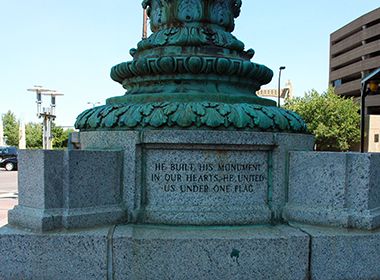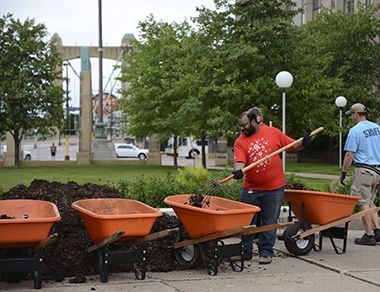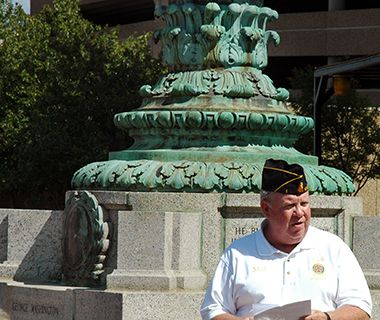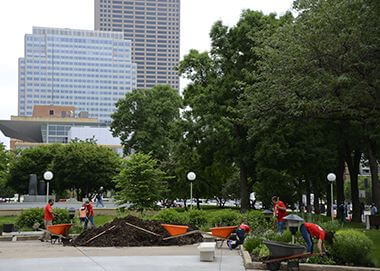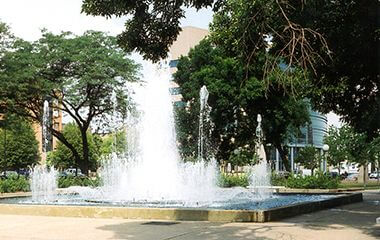Address
1 First St. S
Minneapolis, MN 55401
Plan Your Route
Contact
Phone: 612-230-6400
Email: info@minneapolisparks.org
Park Hours
6 am–midnight
Ordinance PB-2-33
Features & Amenities
- Decorative Fountain
Not finding what you’re looking for?
Search Parks & Destinations
Park Projects
See what’s currently in the works for this park. Some projects may be under the name of the regional park or service area it lives within. View Current Projects
Master Plans
This park will be affected by a completed park or service area master plan. View Master Plans

Your NPP20 money at work:
Maintenance is increasing at all neighborhood parks, thanks to additional annual funding from the 20-Year Neighborhood Park Plan (NPP20). This initiative also funds ongoing rehabilitation and major project to restore neighborhood parks and help address racial and economic equity.
Park Details
Rental & Permits
Outdoor Use and Event Space: Learn how to reserve park space for corporate events, community celebrations, and more.
History
Name: When the park was first envisaged in 1908 it was viewed as a “gateway” to Minneapolis because of its proximity to the train depots. The Gateway would have been one of the first things seen by arriving passengers as they moved from the train stations toward downtown. The name, which had arisen “spontaneously” according to park board proceedings, was officially adopted December 7, 1908. Suggestions were made later to change the name to “Gateway Park” or “Gateway Plaza.”
Acquisition and Development
The present park called The Gateway was acquired from the city in 1962 as part of a deal between the city and park board to reconfigure the old gateway as a part of urban renewal. The good part is that the park board traded 1.52 acres of the old Gateway, which had been the site of the Minneapolis’s first City Hall in 1883, for 1.66 acres of the new Gateway. The bad part of the deal was that in addition to the land swap, the city paid only $184,000 for land that the park board had acquired more than fifty years earlier for $635,000. An increase in land value in that part of downtown of less than 30% in fifty-plus years, suggested the need for urban renewal of the area. (To create enough available land to make the swap, the city vacated Nicollet Avenue and 2nd Street through what became the new park.)
The only constant between the old Gateway and the new was that the flag pole, which had been erected in the original park in 1917—a gift of the Daughters of the American Revolution—was moved to the new Gateway.
The acquisition of The Gateway in 1908 was one of the most controversial decisions of the park board up to that time—and one of its most expensive failures ever. Part of the objection was to the cost of the land. At more than $600,000, it was by far the most expensive acquisition by the park board until it began acquiring property on the Central Riverfront in the 1980s.
Heavyweights in civic affairs lined up on both sides of the issue. Among those opposed were Thomas B. Walker, the creator of the Walker Art Center; Charles Loring, the first president of the park board and known for more than twenty years then as the “Father of Minneapolis Parks;” and, William Folwell, former president of the University of Minnesota and the park board. Loring argued that the park would simply become a hangout for vagrants, and was philosophically opposed to the park board taking land from businesses (his wife owned some of the land, too). Folwell said the park was too small to be useful.
In favor of the acquisition were most business leaders, including Thomas Lowry, who had built the city’s streetcar system. Lowry called the acquisition the most important issue the board had ever considered and hoped the “splendid enterprise” would go forward.
Park board president Jesse Northrup, who first proposed the idea, painted a picture in 1908 of why many thought the Gateway would be positive for the city, as it sat near the entrance to the train station: “Greeted by day with the sight of a beautiful park, and a glimpse of our leading business streets, at night by our three principal avenues brilliantly illuminated as they would be, the stranger visiting our city would receive an impression never to be forgotten, and our own people returning to their homes would experience a new feeling of pleasure and pride that they lived in Minneapolis.”
Park commissioner Edmund Phelps suggested that The Gateway would be the beginning of “redemption” of the neighborhood, which he noted was “not one of which the city is especially proud.” The neighborhood around Bridge Square, between The Gateway and the Hennepin Bridge, was home to dozens of saloons, which were patronized by many mill workers, lumbermen between jobs, and others looking for work.
Park superintendent Theodore Wirth was strongly in the camp of proponents, confident that it would win over critics when it was done.
The park board first dedicated the land for park purposes on June 1, 1908. The debate raged for the rest of the year, but the process of appraisals and assessments was completed and the park board took possession of most of the land in 1909. Because business tenants in many of the buildings acquired had longer-term leases, some quite lucrative for the park board, the board did not raze the buildings on the land until 1913. The park board calculated that the rents it received would eventually pay for improvements to the site. The city formally deeded the old City Hall to the park board in 1912. When the park board did finally level the area, it took out 27 saloons in barely 1½ acres. The costs of buying the land, and improvements, were assessed partly on the neighborhood and partly on property owners citywide.
Wirth’s first plan for the area, published in the 1909 annual report, suggested a renaissance design for a public comfort station and information bureau. In 1914, park commissioner Phelps donated to the board, specifically for the park, a fountain that was the park’s centerpiece. Often referred to as the “Turtle Fountain,” it was relocated to Lyndale Park near the Rose Garden in 1964.
The Gateway was formally dedicated August 15, 1915 when the fountain was finally completed. The legend inscribed on the building that housed the toilets and information bureau read: “More than her gates, the city opens her heart to you.”
Problems emerged immediately. With the park open for only four months, Theodore Wirth expressed his concern in his 1915 annual report. “The building is too small,” he wrote, “for a place of prolonged rest for the army of unemployed that frequent this neighborhood. It was not intended as such, and for this purpose a larger building and grounds are required.” Both Loring and Folwell’s predictions were accurate. Wirth estimated that 8,000-9,000 people used the toilets every day. He immediately recommended a pier or park on city property on Nicollet Island to relieve the overcrowding at The Gateway.
The information bureau was not established in the park building until 1917. The board assumed the bureau would be self-sustaining through the sale of cigars, candy and newspapers. The same year the Daughters of the American Revolution contributed an ornamental flagstaff for the park. In 1919, the Minneapolis Library was given space in the building for a “deposit station.” The park board provided space and furniture for the library “at the pleasure” of the board.
Contrary to the desires of The Gateway’s promoters, it did not lead to renewal of that part of the city. But it did become a place to hang out. In 1921 the Bureau of Public Welfare began using the Gateway building to help the unemployed. It was apparently going where its clients were. The crowds at The Gateway were responsible for one of the major costs of operating the park: police deployments.
In 1923 the park board reported that 5% of the General Park Fund, for maintaining and operating all city parks, was spent at The Gateway. In a bit of understatement the board called the expense “out of proportion” for that small part of the park system.
The hopes of the park board that The Gateway would be self-sustaining were dashed when the city began distributing free road maps at The Gateway in 1925, further cutting into revenues at the board’s information bureau. When the Chamber of Commerce was given permission to open a tourist bureau at the site in 1927, Wirth suggested that the park board relinquish the entire space to that organization.
The Gateway largely disappeared from park board reports and publications for the next 25 years, perhaps out of embarrassment. In 1950, when the Chamber of Commerce closed its tourist bureau, the park board asked whether the park had outlived its usefulness and, to test public sentiment, solicited bids to raze the building. It deferred action at the request of the City Planning Commission, not because there was a public outcry. When the park board talked again of razing the building in 1952, a group of citizens brought suit to stop it. But with a court ruling in the board’s favor, and the City Planning Commission not standing in the way, the building was leveled in 1953 and turned into open space and gardens—with a four foot fence around it. The fountain and flagpole remained.
That changed in 1960 when the city began condemnation proceedings to obtain the park for its neighborhood renewal efforts. Over the next two years the city and the park board negotiated a price for the land, and the eventual relocation of the park to the east.
The new park was built in 1963 after the Phelps Fountain was moved to Lyndale Park. A new fountain was installed in the newer Gateway in 1967.
At the same time the city acquired the old Gateway, it also acquired Pioneer Square, the park in front of the post office (see Pioneer Triangle), as part of its renewal efforts. Sadly, both of the park board’s ventures into downtown were expensive failures.
The Gateway still exists as a small park, but it is barely noticeable, when it was once intended to be the centerpiece of a majestic entrance to the city. The fountain and the flagpole are still worth a visit, and green space anywhere in downtown is pure pleasure, but The Gateway is a far stretch from the glory once envisioned—and paid for.
Park history compiled and written by David C. Smith.








